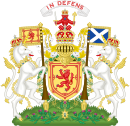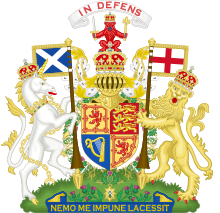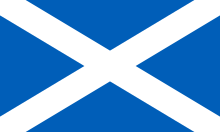Coat of arms of Scotland
| Coat of arms of Scotland | |
|---|---|

|
|
| Details | |
| Shield shape and division | Inboard |
| Heraldic shield | lion |
| Coat of arms | Helmet with crown and lion |
| Helmet cover | gold-Hermelin |
| Sign holder | Unicorn holding standards |
| Motto (motto) | In defens Nemo me impune lacessit. |
The Royal Coat of Arms of Scotland was the official coat of arms of the Kings of Scotland and the Kingdom of Scotland until 1707.
history
The main motif of the coat of arms was established as early as 1332 , a directory in the London College of Arms describes the coat of arms of the "Kyng of Scottz" as:
- "In gold with a red double lily border a rising (red) lion ." ( Or, a lion rampant within a double tressure flory counter-flory Gules. ).
King Wilhelm I the Lion introduced it as the first ruler after 1165, a red upright lion with a forked tail on a yellow field, and was later given his nickname. The core motive was transformed over time (paws position, tail, reinforcement, tincture), the latest version is as follows described :
- "In gold with a red double lily border, a soaring blue-armed and blue-tongued red lion."
- "Or, a lion rampant Gules armed and langued Azure within a double tressure flory counter-flory Gules." (heraldry)
Derived from this there is the Scottish royal flag. This is actually reserved for the Queen and some high-ranking state officials, but is still used, e.g. B. at international football matches, often used as an alternative flag of Scotland .
This crest motif also appears in the coat of arms and flag of the Canadian province of Nova Scotia .
The Scottish version of the British royal coat of arms

This coat of arms is a version of the British royal coat of arms , which differs from the one used in the rest of the United Kingdom mainly by the greater emphasis on Scottish national symbols and by the exchange of symbols from the English Order of the Garter for those of the Scottish Thistle Order .
The escutcheon is four and represents the parts of the country:
- In the 1st and 4th square (left ( heraldic right ) above and right ( heraldic left ) below) the coat of arms of Scotland
- In the 2nd square (top right) the coat of arms of England : three golden lions (or "leopards" ) on a red background.
- In the 3rd square (bottom left) the coat of arms of Ireland : A golden harp on a blue background, which symbolizes Northern Ireland (until 1927 all of Ireland).
The coat of arms decoration consists of a richly decorated spangenhelm , crowned with the Scottish crown . On the crown, in turn, sits a red, crowned lion holding a sword and a scepter , above it the motto of the Scottish royal family In My Defens God Me Defend , In My Defens or just In Defens (English "In [my] defense [ defend me God] "). The spelling "Defens" is an old Scottish spelling of the word "Defense".
The coat of arms is held in place by two shield holders . The heraldic right coat of arms, a unicorn , symbolizes Scotland and carries the flag of Scotland . The heraldic left coat of arms, a crowned lion , stands for England and carries the flag of England . The unicorn is chained because in the Middle Ages it was thought to be a dangerous animal that could only be tamed by a virgin. The unicorn occupies a special place in Scotland's symbolism and mythology . It is supposed to embody the following characteristics, which were already claimed in the Middle Ages, and transfer them to the culture of Scotland: proud, wild, freedom-loving, pure and beautiful. In Christianity, this mythical creature is also associated with chastity and the Holy Virgin Mary .
The lawn on which the coats of arms stand is decorated with a banner with the Latin motto of the Thistle Order:
- " Nemo me impune lacessit. "
- ( Nobody irritates me with impunity. )
Above it you can see some thistles (the Scottish national plant), sometimes also Tudor roses (the English national plant) and shamrocks (the Irish national plant).
When Jacob VI. of Scotland (or James I of Great Britain) became ruler of England and Ireland in 1603, he shared the Scottish coat of arms, with the soaring lion in the first and fourth quarters, the English coat of arms in the second and the golden harp of the Irish in the third. The Act of Union 1707 guaranteed that the royal coat of arms used in Scotland would continue to give priority to symbols for Scotland.
Individual evidence
- ↑ Scotland and the unicorn. Retrieved April 11, 2018 .


